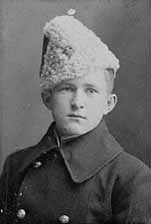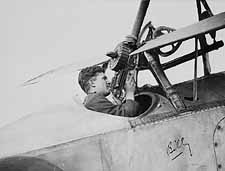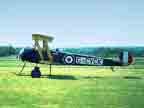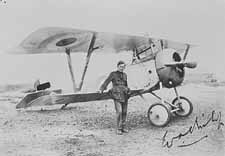|
Whenever they could, Billy and his friends drove three hours
to Amiens, to Charlie's Bar and Le Hôtel du Rhin where
accommodating ladies could be obtained quite cheaply. Billy developed
a contest in which the pilot who charmed a garter from a girl
would hang it as a trophy in the squadron mess. Billy won the
contest. Although he was a womanizer, he developed a strong wartime
romance with a beautiful girl named Ninette.
A dark side was beginning to show in Billy. He made glib remarks
upon seeing the bodies of dead German infantrymen and wrote Margaret:
"You have no idea of how bloodthirsty I've become and
how much pleasure I get in Killing Huns."(8)
On another occasion, on February 8, the date of his twenty-third
birthday, when a two-seat German Rumpler's Parabellum gun jammed
and as the observer struggled to clear the weapon, Bishop coldly
closed in to point blank range and raked the two men with fifteen
rounds from his Lewis gun. Seeing so many of his friends die
in battle may have caused Billy's increasing blood lust. He wept
unashamedly at the death of close friends. During a two-day period
in April, ten of the squadron's eighteen pilots were killed while
Billy drove himself remorselessly. On April 30th,
he had eight separate engagements with the enemy in one fight.
He destroyed ten German planes and two balloons between April
6, and April 30, in 34 engagements, often flying six or seven
hours a day. He viewed hunting enemy planes as a sport and was
called "The Lone Hawk" because he sometimes spent two
to three hours in the air alone searching for German planes,
doing this solo hunting with his squadron leader's permission.
Billy's tour of duty ended in August 1917, and he was awarded
England's highest order, the Victoria Cross for flying alone
and attacking a German airfield some twelve miles behind the
lines. When he returned from this attack, his plane had 17 bullet
holes in it.
Billy returned to Canada for an extended leave. The war-weary
Canadians found a hero in him. He traveled, lectured, and was
promoted to major. With Margaret, who was now his wife, he returned
to England where he took command of 85 Squadron, nicknamed the
"Flying Foxes." He was posted to France in May 1918,
and fought at a frenzied pace from the moment he arrived. Between
May 27th, and June 18th, he downed 20 German
planes. The Canadian government became increasingly concerned
that their national hero would be killed and, on June 18th,
he was ordered to return to Canada the next day. On the 19th,
Bishop went up for "one last look at the war." In fifteen
minutes of furious combat, he shot down five German planes. His
final count was 70 planes and two balloons destroyed.
Billy was not especially successful after World War I ended
until a friend helped him obtain a position as director of sales
for a large Canadian oil company, a job in which he did quite
well. He proved to be an excellent salesman. When World War II
started, the Canadian government offered him the enticing position
of Air Marshall in Charge of Recruitment, a job he did very well
despite his extreme fun-loving nature and heavy drinking. Billy
went into semi-retirement after World War II ended. He developed
a very active social life but partied and drank far too much.
He tried to enlist in the Royal Canadian Air Force during the
Korean War but was turned down. He died quietly in his sleep
in 1956 at age 62 and was given the largest funeral Canada had
seen to that time.
However, Billy's story wasn't over. A debate raged over his
being awarded the Victoria Cross. No one saw him attack the German
airfield; the medal was awarded only on what he claimed he did.
He was the only Victoria Cross winner not to have his deeds witnessed
or proved. The Canadian National Film Board released a film about
Billy, The Kid Who Couldn't Miss, a 'docudrama' that claimed
Billy had falsified many of his exploits. The Canadian Government
Standing Senate Committee on Social Affairs, Science and Technology
investigated and completely discredited this film, finding it
both unfair and inaccurate.
There are two additional but different bits of information
necessary to complete the saga of Billy Bishop. The first is
that a musical comedy about Billy, Billy Bishop Goes To War
was one of the most successful made-in-Canada musicals ever made.
The second item concerns an event took place on September 1,
2001, the day the Billy Bishop Heritage Museum in Own Sound,
Ontario was burglarized. One of the items stolen was a small
chunk of shrapnel reportedly given to Bishop by Winston Churchill.
|



